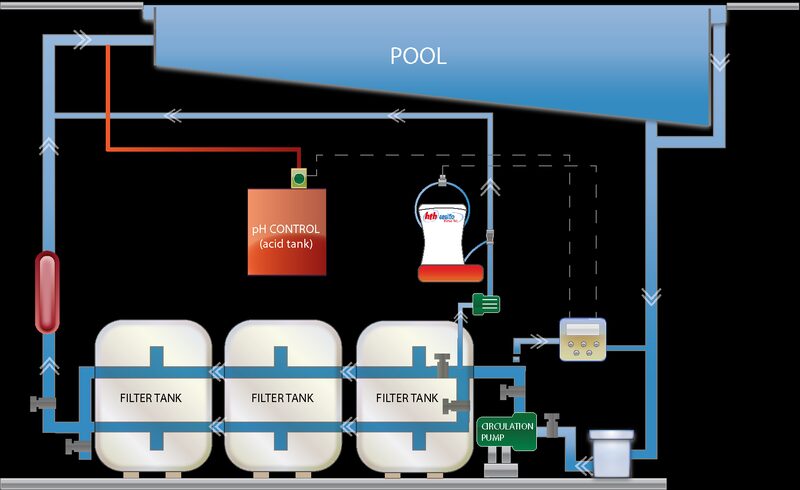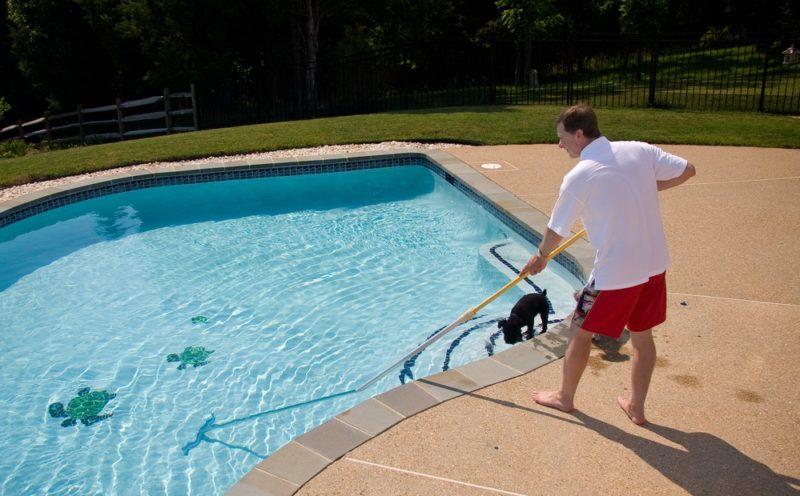To keep water clear, regular maintenance is required. This maintenance involves: removal of mechanical impurities, removal of bacteria and algae, and maintenance of the PH value.
Mechanical impurities

source:bluewaterspoolservices.com
Mechanical impurities, such as leaves and dust, are removed using a filter and a water vacuum cleaner. It is imperative that you have this device, for cleaning the bottom, because this is the only way you can clean everything. Otherwise, the bottom will be dirty, because only the floating particles will reach the filter.
Disinfection

source:poolsidenews.org
Pool owners need to be sure that no harmful bacteria, viruses and algae are present in it. Bacteria, viruses and other microorganisms are brought in by the swimmers, and if the water is not treated, then the bacteria multiply. To keep everything safe, it must be disinfected. There are different ways to disinfect, and the most common are: via chlorine, using a UV lamp, and an electrolysis-based system.
What is the circulatory system and why is it so important?

source:hth.com
The circulation system is most responsible for the purity. The pump, filter, skimmer, sewer, and nozzles or water inlets are parts of the system. These parts work together to keep everything clean.
Quality purification pumps are key. The size of the pool and the number of bathers determine the volume of the pump. Higher volume and better pump quality will help you maintain your system.
Your pump and filter work together to circulate it and eliminate impurities. If you have a cartridge filter, you need to remove the cartridge and clean it. If you have a sand one, you need to do backwash regularly to keep it clean. Keeping it clean will allow better circulation and prevent your pump from running “overtime” to keep the circulation running.
The sand filtration device, which is used for mechanical filtration, consists of a pre-filter pump, a quartz sand-filled filtration tank and a multifunction valve to operate the filtration device. The product is rinsed at least once a week to remove any impurities it has collected during its operation. If necessary, flushing during intensive use of the pool may be more frequent, and a manometer on the filtration tank is used as an indicator of soiling, indicating the degree of saturation of the filtration device.
Remember, each pool is unique and the way it is maintained can vary. You can always seek advice or help. The filter should be cleaned every 4 to 6 months. Clean the debris from the filter, rinse the filter, let it dry, return it and that’s it.
The skimmer (suction element) for the pool serves as a collector of surface impurities. Helps remove leaves, insects and other surface impurities in the pool. It is UV resistant. Empty the skimmer basket regularly from leaves and other impurities. This prevents the pump from running smoothly and possibly clogging the system. The impurity is retained in an overflow removable grille and can be cleaned. Part of the skimmer is an overflow damper that evenly supplies it and prevents air from entering it.

source:pxfuel.com
It is located along the upper edge of the pool and can be fitted with a vacuum cleaner attachment in the form of a plate with a center hole. It can be for tiles or pvc lined swimming pools. Also, even though you already have a skimmer, it is advisable to choose a place that is not surrounded by deciduous trees, because besides cleaning the leaves from the pool is a great boredom, it also has a negative effect on the level of purity.
In addition to the drainage function , the drain (suction element) plays an important role in the circulation, drawing the lower layers of water into the filtration device.
The blowers return the filtered water from the opposite side, pushing it against the suction elements. Consequently, they are located on the opposite side – relative to the skimmer and the drain (suction elements), and at the same time returning pre-filtered water should also push towards the suction elements. The number and accommodation depends on the volume and depth of it, ie the capacity of the filtration unit.
Lastly, keep in mind that the pool (of whatever type) should be easily connected to the sewer and supply network.
In order for the water to always be crystal clear and to meet chemical standards for bacteriological and chemical safety, it is necessary to constantly filter it mechanically with proper use of conditioners. In order for the layers of water to circulate freely and to be brought to a mechanical filtration device and returned after filtration, it is necessary to install properly dimensioned elements for the circulation of water. If you want to further improve circulation, read more here.
How does it work?
The principle of operation is simple: the water is sucked out of the pool, passes through a filter that releases it from impurities and sends it back to the tank.
In underground infinity pools, with water flowing into the channels, a compensation tank is needed from which the filter pumps suck in the water and then return it to the bottom through the lower openings.

source:poolsidenews.org
Maintenance of the circulation system
Regular removal of large impurities from the pool surface (leaves, twigs, etc.) will help your system do its job more efficiently. Vacuuming the bottom of the pool will also help your system keep the water ready for bathing. Washing your filters regularly and following the instructions will ensure that your system is running smoothly. If you need help or advice, we are here to help you enjoy the hot summer days this season as well.
We all make mistakes when it comes to pool maintenance, but experience is paramount. Following these instructions will give you more time to relax and have fun.
Conclusion:
The right combination and balance between physical treatments, filtration and chemicals guarantees you safe swimming from all aspects. Remember, the more efficient the circulation system is, the less need to use chemicals.

